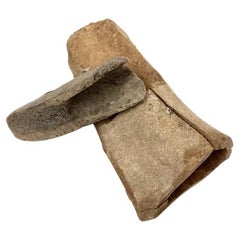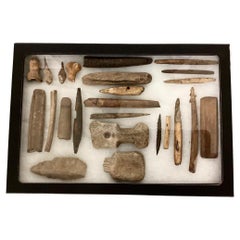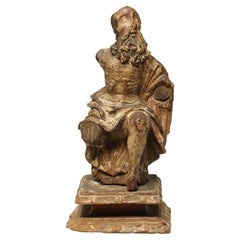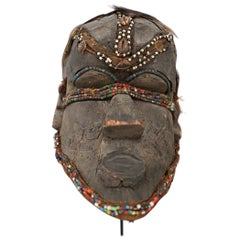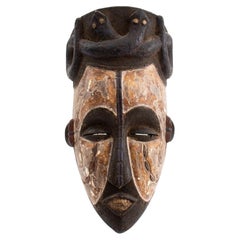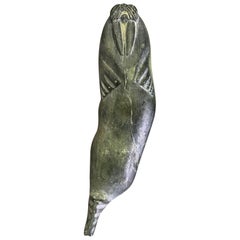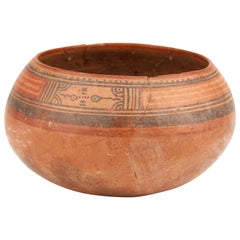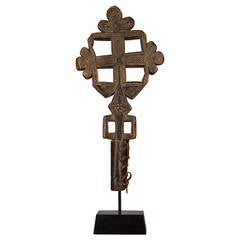17th Century Tribal Art
4
to
3
1
4
4
4
50
182
982
34
384
378
67
8
1
15
20
18
31
25
14
14
5
2
2
1
1
1
1
1
1
1
1
Period: 17th Century
Two Pre Inuit Thule Culture Bone Tool Handles
Located in Bridgeport, CT
Two carved bone tool Handles from the Pre-Inuit Thule Culture in all original condition. Probable wood working tools, the handles once held Stone or, more rarely, Iron blades. The la...
Category
Tribal Antique 17th Century Tribal Art
Materials
Bone
Pre Inuit/ Eskimo Thule Culture Artifacts
Located in Bridgeport, CT
A curated collection of Pre Inuit Thule Culture (1,200-1,600 A.D.) Artifacts housed in a Museum Style Frame. The Collection includes various implements used in daily life by the wide...
Category
North American Tribal Antique 17th Century Tribal Art
Materials
Stone
Antique 17th-18th Century Wood Italian Seated Saint Figure Fragment with Beard
Located in Point Richmond, CA
Antique 17th-18th century Italian carved wood seated saint figure fragment with beard. Possibly earlier. Remains of paint or pigments.
Arms and one leg missing, old damage to nose and other areas. Mounted on vintage base...
Category
Italian Medieval Antique 17th Century Tribal Art
Materials
Wood
Kuba Mask African Bwoom Tribal Congo in Wood, Vibrates Vegetables, Animal Hair
Located in Milano, IT
The African Kuba Bwoom tribal mask is the oldest known mask, the Kuba bwoom mask. The materials used for the realization of the Mask are: Wood, colors and vibrates plants, caures, beads, animal hair. In dance it expresses exuberance and joy. The style is similar to that of the middle Kasai. This mask is a helmet with animal hair, carved with a very wide forehead and hollow cheeks that are announced by motifs or dashes and beads. The mouth of the mask is very pronounced carved in wood and then applied on the mask. To distinguish the forehead in different areas are used black and white beads to draw attention to other aspects of the face such as the nose and chin. The entire edge of the chin is surrounded by beads of various colors. The person wearing the mask cannot look because there are no holes for the eyes present; the mask must create the feeling of being blind. Some masks similar to the bwoom mask include the funny mask, the ram mask and initiation masks such as Nnup.
The real Kuba masks...
Category
Congolese Tribal Antique 17th Century Tribal Art
Materials
Animal Skin, Organic Material, Wood
Related Items
African Dogon Manner Tribal Face Mask
Located in New York, NY
African Dogon manner tribal face mask, in the style of the Dogon peoples of Mali.
Dimensions: 12" H x 6" W (approx)
Dealer: S138XX.
Category
Tribal 17th Century Tribal Art
Materials
Wood
Inuit Native American Eskimo Signed Stone Carved Walrus Sculpture
Located in Studio City, CA
A wonderful soapstone carving of a walrus by the indigenous Inuit People who inhabit parts of the arctic regions of Greenland, Canada, and Alaska.
Signed ("E.Y.") and numbered/dat...
Category
Canadian Native American 17th Century Tribal Art
Materials
Soapstone
18th Century French or Italian Santo Nativity Figure
Located in Nantucket, MA
18th century French or Italian Santo Nativity Figure, a hand carved and painted fruitwood figure for a Christmas Crèche or Krippe. Excellent and delicate details to the head and hands. The half figure stands on a dowel set into platform base, dressed in original fine linen robe...
Category
Italian Folk Art Antique 17th Century Tribal Art
Materials
Linen, Fruitwood
Inuit Native American Eskimo Signed Large Stone Carved Tusked Walrus Sculpture
Located in Studio City, CA
A wonderful soapstone large, heavy carving of a tusked walrus by the indigenous inuit people who inhabit parts of the Arctic regions of Greenland, Canada, and Alaska.
Signed on th...
Category
Canadian Native American 17th Century Tribal Art
Materials
Soapstone
H 6 in W 15 in D 6.5 in
18th-19th Century Italian Wood Carved Angel
Located in San Francisco, CA
A lovely angel, his right hand extended as if to touch something or hold
something. He appears very calm and peaceful, clothed in a partial shroud
which is draped over his shoulder...
Category
Italian Baroque Antique 17th Century Tribal Art
Materials
Wood
Pre Columbian Large Inca Early Colonial period Wood Kero South American Antiques
Located in London, GB
Large Pre Columbian INCA / Early Colonial period Wood Kero
A superb Large Inca Kero cup profusely carved in the mosaic style with a image of the Inca or...
Category
Peruvian Antique 17th Century Tribal Art
Materials
Wood
H 9.45 in W 6.3 in D 5.12 in
Pre Columbian Narino Carchi Coquero Coca chewer Figure Columbia
Located in London, GB
A hand modelled statue of a male coca chewer figure , known as a Coquero, wearing a sash sitting upon a bench, the coca quid in his right cheek, with black negative resist design
Pr...
Category
Colombian Antique 17th Century Tribal Art
Materials
Pottery
Free Shipping
H 7.09 in W 5.52 in D 4.73 in
Old African Songye Female Kifwebe Wall Mask with Expressive Face Large Sized
Located in Torquay, GB
Large sized Songye Female Kifwebe mask from The Congo circa 1920s.
Traditionally, the Kifwebe mask is very symbolic in the Bantu culture of central Africa.
Its striking colours and carving symbolise the battle between good and evil.
Female Kifwebe masks represent femininity, the continuation of life and a good omen.
These masks were used for wedding ceremonies, reproduction rituals and other such occasions.
This large mask...
Category
Congolese Tribal 17th Century Tribal Art
Materials
Wood
H 13.78 in W 7.88 in D 6.7 in
Tribal Style Songye Kifwebe Mask, D. R. Congo
Located in Point Richmond, CA
This graphic Songye Kifwebe mask has fine carved lines curved over the eyes and diagonal lines radiating from the nose and mouth in classic Kifwebe form. ...
Category
Congolese Tribal 17th Century Tribal Art
Materials
Wood
Ashanti Maternal Fertility Figure
Located in Atlanta, GA
On offer is an Ashanti female fertility figure from Ghana, West Africa, circa Mid-20th century. Carved from a single block of wood, the statue depicts a female with typical coiffure ...
Category
Ghanaian Tribal 17th Century Tribal Art
Materials
Glass, Wood
Framed Pre-Columbian Proto Nazca Textile Frangment
Located in Atlanta, GA
A Proto-Nazca textile fragment from Southern Peru circa 100BC-200AD. The linked munecas ("dolls" in Spanish) figures were woven with fibers likely from l...
Category
Peruvian Pre-Columbian Antique 17th Century Tribal Art
Materials
Wool
Pre Columbian Maya Polychrome Pottery Bowl circa A.D. 550-950
Located in London, GB
Maya Poly-chrome painted pottery bowl
Guatemala/ central America late Classic period, circa A.D. 550-950,
A bowl of rounded bottom circular form, painted with a frieze of monkey...
Category
Guatemalan Antique 17th Century Tribal Art
Materials
Pottery
Previously Available Items
Pre-Columbian Costa Rican Nicoya Pottery Bowl
Located in New York, NY
Pre-Columbian Nicoya pottery bowl from the Costa Rican Guanacaste Province, made in the 17th century. A round-bottomed red clay bowl painted with geometric designs and natural pigmen...
Category
Costa Rican Pre-Columbian Antique 17th Century Tribal Art
Materials
Clay
17th Century Processional Hand Cross, Ethiopia
Located in New York, NY
A large and unusual wood and leather hand cross.
Ethiopian hand crosses are coveted by collectors of medieval art, religious art and tribal art for their beauty and variety of forms.
Ethiopia was probably the second country after Armenia to embrace the Christian faith. There is evidence that Christianity thrived in the country even in the 1st century and for most of the country's history since, the state religion has been Orthodox Christianity.
After the invasion of Ahmed Gra'an in the 16th century, and the devastation of Ethiopian highlands, wooden crosses often replaced metal ones even in less remote regions, replicating irrigate patterns of metal artistry in more available material.
This example is an unusual square style. Another hand cross of this type can be found in collection of the IES Museum in Addis Ababa and probably originates from Gojam Province, Western Ethiopia.
Ethiopian crosses...
Category
Antique 17th Century Tribal Art
Materials
Wood, Leather
17th century Hand Cross, Ethiopia
Located in New York, NY
A large and fine liturgical hand cross.
Ethiopian hand crosses are coveted by collectors of medieval art, religious art and tribal art for their beauty and variety of forms.
Ethiopia was probably the second country after Armenia to embrace the Christian faith. There is evidence that Christianity thrived in the country even in the 1st century and for most of the country's history since, the state religion has been Orthodox Christianity.
After the invasion of Ahmed Gra'an in the 16th century, and the devastation of Ethiopian highlands, wooden crosses often replaced metal ones even in less remote regions, replicating irrigate patterns of metal artistry in more available material.
This example is a large liturgical wooden hand cross with pigments from Tigray, Ethiopia. The style is typical of the Northern Ethiopian province of Tigray from 1700 on. These larger long shafted hand crosses would usually be used within church ceremonies for blessing the faithful and were often confined to more remote monastic settings.
Ethiopian crosses are unique among Christian art for their variety of form. Ethiopian crosses are invariably made from elaborate lattice work. Hand-held crosses usually include a square at the base, which represents the Ark of the Covenant. Geometric patterns are common in Ethiopian art...
Category
Ethiopian Antique 17th Century Tribal Art
Materials
Wood
17th century Hand Cross, Ethiopia
Located in New York, NY
‘Horn of Lamb of God’ wooden hand cross, circa 17 century, Northern Ethiopia
Ethiopian hand crosses are coveted by collectors of medieval art, religious art and tribal art for their beauty and variety of forms.
Ethiopia was probably the second country after Armenia to embrace the Christian faith. There is evidence that Christianity thrived in the country even in the 1st century and for most of the country's history since, the state religion has been Orthodox Christianity.
After the invasion of Ahmed Gra'an in the 16th century, and the devastation of Ethiopian highlands, wooden crosses often replaced metal ones even in less remote regions, replicating irrigate patterns of metal artistry in more available material.
This example is an unusual square style. Another hand cross of this type can be found in collection of the IES Museum in Addis Ababa and probably originates from Gojam Province, Western Ethiopia.
Ethiopian crosses...
Category
Ethiopian Antique 17th Century Tribal Art
Materials
Wood
